Documentaries
The History of the River in Documentary Film
Documentaries
The History of the River in Documentary Film
Documentaries
The History of the River in Documentary Film
Documentaries
In addition to the Welcome videos, this website includes three films about the lower Flathead River: The Place Of The Falling Waters (the history of the Flathead Reservation as seen through the relationship between the Tribes and Kerr Dam), The River Is Wider Than It Seems (about an Army Corps of Engineers' proposal to build additional dams on the river), and The River Lives (a film about traditional tribal life along the river). These films bring into focus the history of the river and our relationship to it. Students might watch the films and then answer the question: Is being tied to the natural world and more specifically to a specific place important? Why or why not?
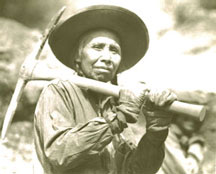
The Place of the Falling Waters
90 minutes
This Native American produced film relates the complex and volatile relationship between the people of the Confederated Salish and Kootenai Tribes and a major hydroelectric dam. It is presented in three, 30 minute parts: (1) a history of tribal society and culture before the dam's construction; (2) the construction of Kerr Dam in the 1930's and its impact on the reservation; and (3) the hopes and dilemmas of the Salish and Kootenai people as they prepare to take over Kerr Dam during the next three decades. The film is one of the best histories of the Flathead Indian Reservation ever produced in any medium.
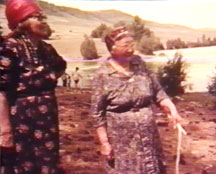
The River is Wider than it Seems
55 minutes
(Note: The very beginning of this print of the film is in poor condition, but it gets better, so stay with it.)
In the film, John Stern examines the U.S. Army Corps of Engineers plans to build dams along the Lower Flathead River. Shot in the late 1970s, the film does an excellent job of presenting both sides of an age-old dilemma: do we dam a beautiful river to produce power, jobs, and money or do we protect the river for fish, wildlife, and future generations. The film can set the stage for a great classroom discussion about arguments for and against development of the natural world and the politics of resource development on an Indian reservation in the 1970s. It would also make a great "watch and write" assignment for students.

The River Lives
43 minutes
The people interviewed in the video tell the story of traditional life along the Flathead River and the importance of keeping the river the way it is. Produced in 1985, the film includes interviews with a number of prominent cultural leaders. It shows how important "a sense of place" is to tribal people. As Pat Pierre says, "The people always had a deep respect for the flow of the river. They went down there just to be a part of it—to be a part of life." Students might contrast their lives and lifestyles with those of the people in this film and participate in a discussion about why a sense of place might be important and the implications for society.
Documentaries
In addition to the Welcome videos, this website includes three films about the lower Flathead River: The Place Of The Falling Waters (the history of the Flathead Reservation as seen through the relationship between the Tribes and Kerr Dam), The River Is Wider Than It Seems (about an Army Corps of Engineers' proposal to build additional dams on the river), and The River Lives (a film about traditional tribal life along the river). These films bring into focus the history of the river and our relationship to it. Students might watch the films and then answer the question: Is being tied to the natural world and more specifically to a specific place important? Why or why not?

The Place of the Falling Waters
90 minutes
This Native American produced film relates the complex and volatile relationship between the people of the Confederated Salish and Kootenai Tribes and a major hydroelectric dam. It is presented in three, 30 minute parts: (1) a history of tribal society and culture before the dam's construction; (2) the construction of Kerr Dam in the 1930's and its impact on the reservation; and (3) the hopes and dilemmas of the Salish and Kootenai people as they prepare to take over Kerr Dam during the next three decades. The film is one of the best histories of the Flathead Indian Reservation ever produced in any medium.
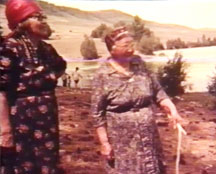
The River is Wider than it Seems
55 minutes
(Note: The very beginning of this print of the film is in poor condition, but it gets better, so stay with it.)
In the film, John Stern examines the U.S. Army Corps of Engineers plans to build dams along the Lower Flathead River. Shot in the late 1970s, the film does an excellent job of presenting both sides of an age-old dilemma: do we dam a beautiful river to produce power, jobs, and money or do we protect the river for fish, wildlife, and future generations. The film can set the stage for a great classroom discussion about arguments for and against development of the natural world and the politics of resource development on an Indian reservation in the 1970s. It would also make a great "watch and write" assignment for students.
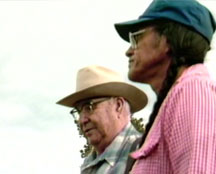
The River Lives
43 minutes
The people interviewed in the video tell the story of traditional life along the Flathead River and the importance of keeping the river the way it is. Produced in 1985, the film includes interviews with a number of prominent cultural leaders. It shows how important "a sense of place" is to tribal people. As Pat Pierre says, "The people always had a deep respect for the flow of the river. They went down there just to be a part of it—to be a part of life." Students might contrast their lives and lifestyles with those of the people in this film and participate in a discussion about why a sense of place might be important and the implications for society.
Documentaries
In addition to the Welcome videos, this website includes three films about the lower Flathead River: The Place Of The Falling Waters (the history of the Flathead Reservation as seen through the relationship between the Tribes and Kerr Dam), The River Is Wider Than It Seems (about an Army Corps of Engineers' proposal to build additional dams on the river), and The River Lives (a film about traditional tribal life along the river). These films bring into focus the history of the river and our relationship to it. Students might watch the films and then answer the question: Is being tied to the natural world and more specifically to a specific place important? Why or why not?

The Place of the Falling Waters
90 minutes
This Native American produced film relates the complex and volatile relationship between the people of the Confederated Salish and Kootenai Tribes and a major hydroelectric dam. It is presented in three, 30 minute parts: (1) a history of tribal society and culture before the dam's construction; (2) the construction of Kerr Dam in the 1930's and its impact on the reservation; and (3) the hopes and dilemmas of the Salish and Kootenai people as they prepare to take over Kerr Dam during the next three decades. The film is one of the best histories of the Flathead Indian Reservation ever produced in any medium.

The River is Wider than it Seems
55 minutes
(Note: The very beginning of this print of the film is in poor condition, but it gets better, so stay with it.)
In the film, John Stern examines the U.S. Army Corps of Engineers plans to build dams along the Lower Flathead River. Shot in the late 1970s, the film does an excellent job of presenting both sides of an age-old dilemma: do we dam a beautiful river to produce power, jobs, and money or do we protect the river for fish, wildlife, and future generations. The film can set the stage for a great classroom discussion about arguments for and against development of the natural world and the politics of resource development on an Indian reservation in the 1970s. It would also make a great "watch and write" assignment for students.
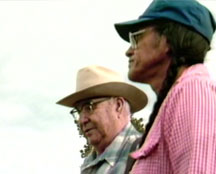
The River Lives
43 minutes
The people interviewed in the video tell the story of traditional life along the Flathead River and the importance of keeping the river the way it is. Produced in 1985, the film includes interviews with a number of prominent cultural leaders. It shows how important "a sense of place" is to tribal people. As Pat Pierre says, "The people always had a deep respect for the flow of the river. They went down there just to be a part of it—to be a part of life." Students might contrast their lives and lifestyles with those of the people in this film and participate in a discussion about why a sense of place might be important and the implications for society.